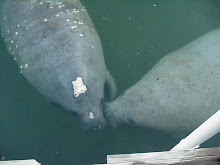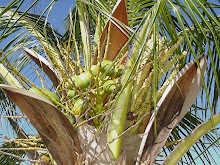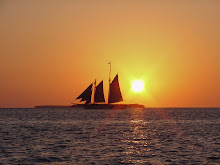First stop...feed the squirrels one last time and then off to the famous Fountain of Youth.
It had changed a little since we were there seven years ago.
On our way to the fountain we saw peacocks that wandered the grounds and made use of the many cannons on display.
 There was an albino peacock that I thought looked like a huge snowflake.
There was an albino peacock that I thought looked like a huge snowflake. We entered the building where the fountain was. It looked exactly the same.
We entered the building where the fountain was. It looked exactly the same.On the ground is an inlaid cross and legend has it that Juan Ponce de Leon put it there to commemorate his discovery of the Fountain of Youth here in 1513. There are 15 stones down the body of the cross and 13 more stones on the cross bar for the year of discovery.
 There are life-sized dioramas depicting Ponce de Leon meeting the indigenous people, the Timucuans.
There are life-sized dioramas depicting Ponce de Leon meeting the indigenous people, the Timucuans. Ponce de Leon believed this fountain was the famed Fountain of Youth because the chief of the Timucuans was over seven feet tall and there were Indians that were older than anyone he had ever seen. The average height for a Spaniard was five foot and most did not live to beyond 45 or 50 years old. I don't blame him, in his shoes, I would have probably thought the same thing.
Ponce de Leon believed this fountain was the famed Fountain of Youth because the chief of the Timucuans was over seven feet tall and there were Indians that were older than anyone he had ever seen. The average height for a Spaniard was five foot and most did not live to beyond 45 or 50 years old. I don't blame him, in his shoes, I would have probably thought the same thing.Of course The Colonel and I drank some of the water from the fountain. It has a somewhat sulfury smell and taste, but just in case, right? I drank two cups when we were there in 2003 and I think I haven't hardly aged at all since then (could be due to the routine application of hair color every 4 to 6 weeks).



He breech-loaded the cannon and looked over the fort wall saying with a Spanish accent, "See those people over there, they don't look Spanish."
 He then lit the end of a piece of rope with a magnifying glass, to create an ember to touch off and fire the cannon with.
He then lit the end of a piece of rope with a magnifying glass, to create an ember to touch off and fire the cannon with.

This cannon firing was a very nice, new addition to the Fountain of Youth Park experience.
Firing cannons makes one hungry, so it was off to lunch at the Columbia Restaurant again.
The Colonel and I were seated and moments later we saw a crowd of people outside the restaurant with huge, expensive looking cameras. It looked like Paparazzi. We thought perhaps someone famous was having lunch and was due to step out the door at any time.
Well, me being me, I got up from our table and made my way outside. There was even a security guard outside. A possible bodyguard of the famous diner, clearing a safe egress path for Jennifer Lopez perhaps? I had my camera in hand just in case that was the case.
I asked someone in the crowd what was going on.
It was a photographic club that met once a month to take pictures all around St. Augustine.
Back at the table, I let The Colonel and our waitress know what I'd found out.
After a delicious lunch we toured the Spanish Military Hospital Museum.

It was a military hospital so women and children were not allowed in, except into the Mourning Room. A priest would be there for Confession and Last Rights.



One thing every patient received in the evening was hot chocolate. This was an order that came down from the Spanish King himself. The Spanish understood that chocolate has many health benefits associated with it.
The Apothecary was next on the tour. On the table were many herbs on display and our guide told us how they were used by the Spanish. The hospital grew many of its own herbs for medicines in a garden behind the building.

The tour was very interesting and our tour guide was very knowledgeable. From the questions and comments The Colonel and I made throughout the tour he asked if we were in the medical field. This museum is a must see when you are visiting St. Augustine.
Our time in St. Augustine was over and it was time to go back down to Daytona Beach and pick Spud back up from Embry-Riddle. As we were heading out of St. Augustine we saw a sign for a historical beach called Frank Butler Beach. This beach was once for blacks only during the days of segregation. It was named for Frank Butler, a prominent black businessman of St. Augustine. The beach was beautiful.
When we arrived in Daytona Beach, we had a little bit of time before it was time to pick Spud up, so we stopped to check out The World's Most Famous Beach. We did not drive on the beach (which it is famous for), we just walked it.

 We arrived at Embry-Riddle, watched as all 200 cadets were called, one at a time, to receive a certificate of graduation from the S.T.E.M. course they attended that week.
We arrived at Embry-Riddle, watched as all 200 cadets were called, one at a time, to receive a certificate of graduation from the S.T.E.M. course they attended that week.We then drove to The Colonel's sister's house to spend the weekend so that we could take Spud on a college tour of the University of Central Florida (UCF) in Orlando on that following Monday, before we headed back home. Nice university and campus. Almost made The Colonel and I want to go back to school (almost).




































No comments:
Post a Comment